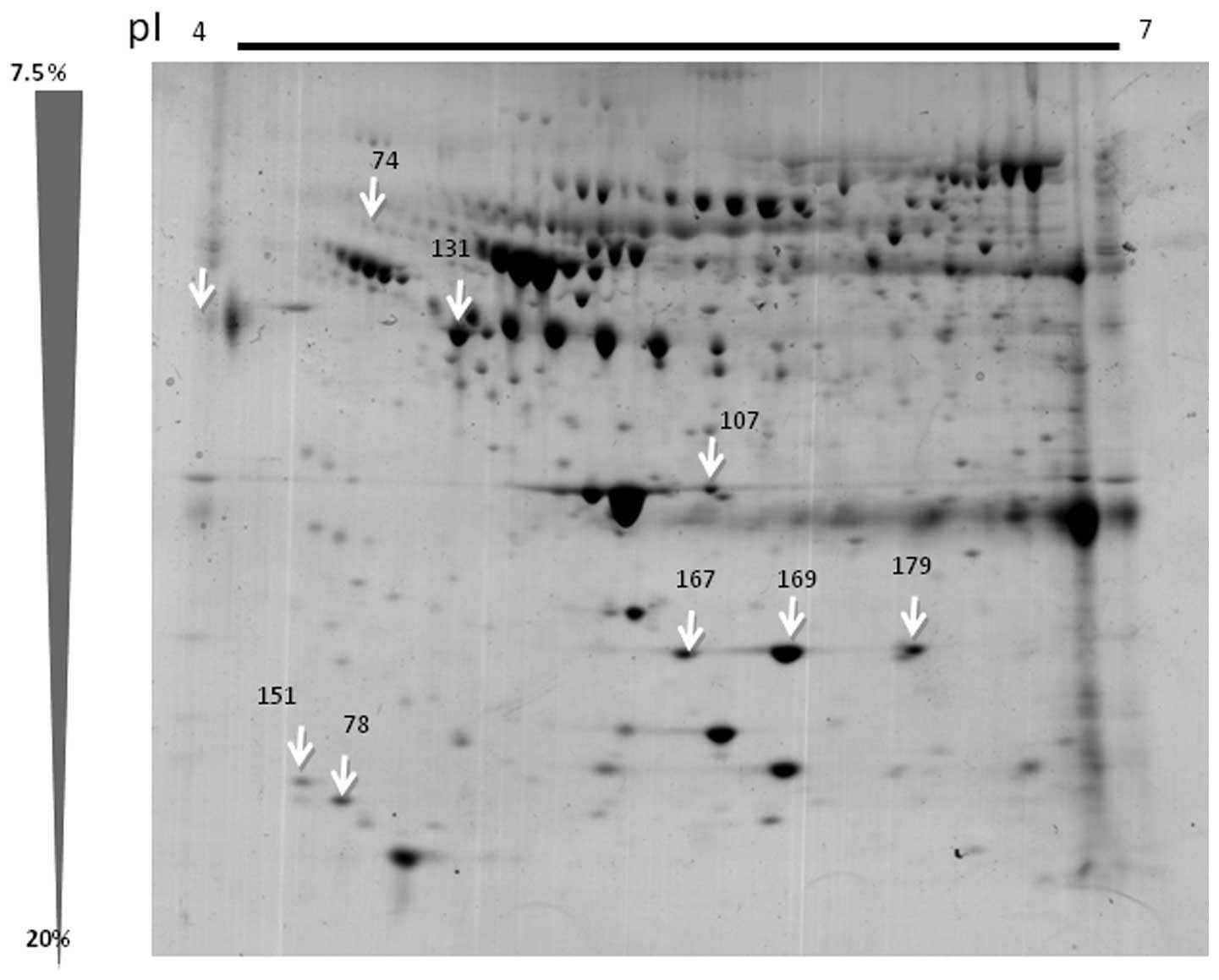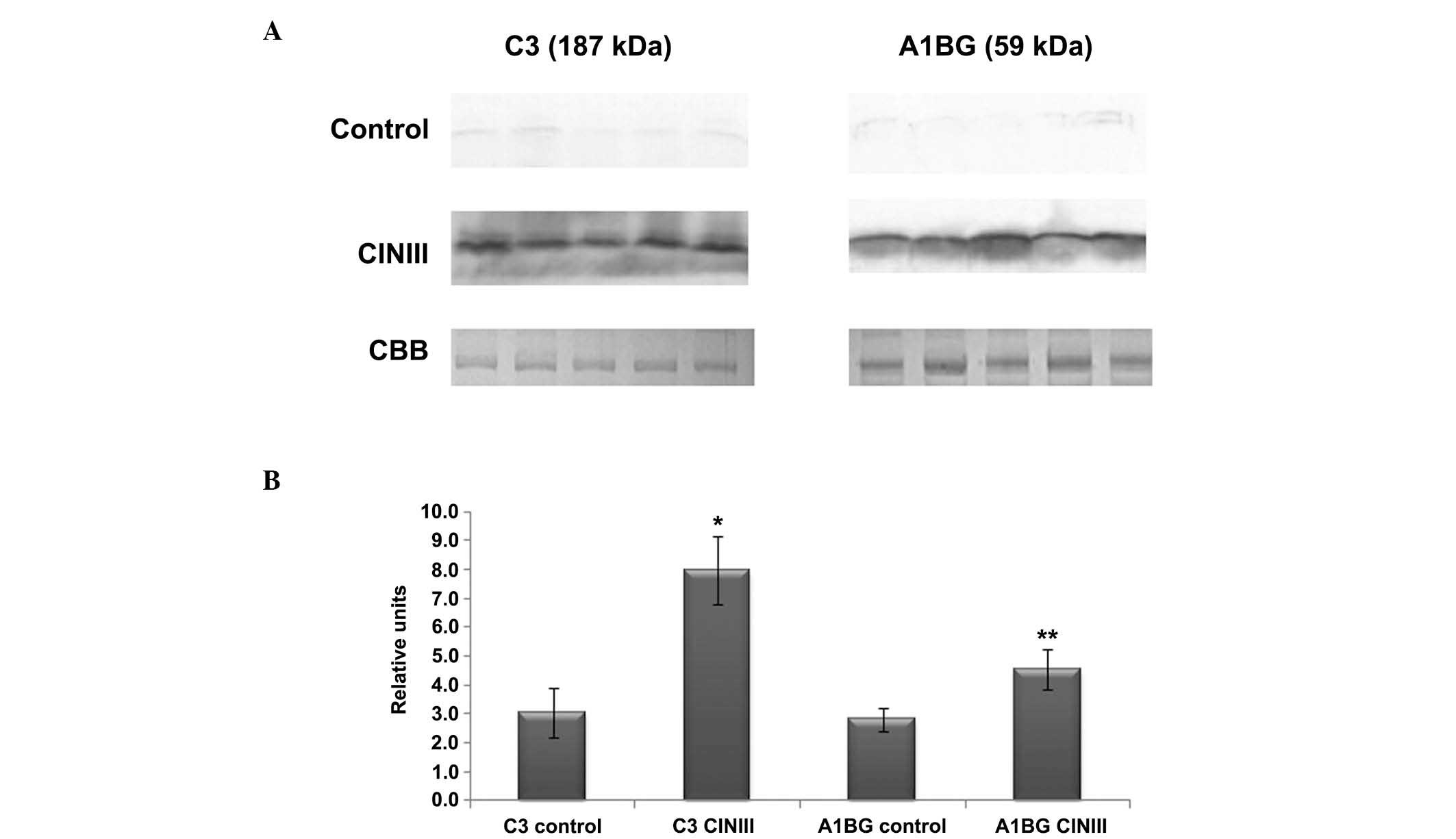|
1
|
Weiderpass E and Labrèche F: Malignant
tumors of the female reproductive system. Saf Health Work.
3:166–180. 2012.
|
|
2
|
Ferlay J, Shin HR, Bray F, et al:
Estimates of worldwide burden of cancer in 2008: GLOBOCAN 2008. Int
J Cancer. 127:2893–2917. 2010.
|
|
3
|
Jemal A, Bray F, Center MM, et al: Global
cancer statistics. CA Cancer J Clin. 61:69–90. 2011.
|
|
4
|
Bruni L, Barrionuevo-Rosas L, Serrano B,
et al: Human Papillomavirus and Related Diseases Report. Mexico:
http://www.hpvcentre.net/statistics/reports/MEX.pdf.
Accessed March 17, 2014
|
|
5
|
Richart RM: Cervical intraepithelial
neoplasia. Pathol Annu. 8:30–28. 1973.
|
|
6
|
Richart RM: A modified terminology for
cervical intraepithelial neoplasia. Obstet Gynecol. 75:131–133.
1990.
|
|
7
|
Solomon D, Davey D, Kurman R, Moriarty A,
O‘Connor D, Prey M, et al: The 2001 Bethesda System: terminology
for reporting results of cervical cytology. JAMA. 287:2114–2119.
2002.
|
|
8
|
Syrjänen K: Histology, classification and
natural history of cervical intraepithelial neoplasia (CIN). CME J
Gynecol Oncol. 14:4–21. 2009.
|
|
9
|
Correa P: A human model of gastric
carcinogenesis. Cancer Res. 48:3554–3560. 1988.
|
|
10
|
Lie AK, Risberg B, Borge B, Sandstad B,
Delabie J, Rimala R, et al: DNA- versus RNA-based methods for human
papillomavirus detection in cervical neoplasia. Gynecol Oncol.
97:908–915. 2005.
|
|
11
|
Wright TC Jr: Cervical cancer screening in
the 21st century: is it time to retire the Pap smear? Clin Obstet
Gynecol. 50:313–323. 2007.
|
|
12
|
Burd E: Human papillomavirus and cervical
cancer. Clin Microbiol Rev. 16:1–17. 2003.
|
|
13
|
Snijders PJ, Heideman DA and Meijer CJ:
Methods for HPV detection in exfoliated cell and tissue specimens.
APMIS. 118:520–528. 2010.
|
|
14
|
Grubisić G, Klarić P, Jokanović L, et al:
Diagnostic approach for precancerous and early invasive cancerous
lesions of the uterine cervix. Coll Antropol. 33:1431–1436.
2009.
|
|
15
|
Cho W: Proteomics technologies and
challenges. Genomics Proteomics Bioinformatics. 5:77–85. 2007.
|
|
16
|
Breuer EK and Murph MM: The role of
proteomics in the diagnosis and treatment of women’s cancers:
current trends in technology and future opportunities. Int J
Proteomics. 2011:1–17. 2011.
|
|
17
|
Veenstra TD, Conrads TP, Hood BL, et al:
Biomarkers: mining the biofluid proteome. Mol Cell Proteomics.
4:409–418. 2005.
|
|
18
|
Xu X and Veenstra TD: Analysis of
biofluids for biomarker research. Proteomics Clin. 2:1403–1412.
2008.
|
|
19
|
Abdul-Rahman PS, Lim BK and Hashim OH:
Expression of high-abundance proteins in sera of patients with
endometrial and cervical cancers: analysis using 2-DE with silver
staining and lectin detection methods. Electrophoresis.
28:1989–1996. 2007.
|
|
20
|
Barba de la Rosa AP, Lugo-Melchor OY,
Briones-Cerecero EP, Chagolla-López A, de León-Rodríguez A, Santos
L, et al: Analysis of human serum from women affected by cervical
lesions. J Exp Ther Oncol. 7:65–72. 2008.
|
|
21
|
Matthews R, Azuero A, Asmellash S, et al:
Usefulness of serum mass spectrometry to identify women diagnosed
with higher grades of cervical intraepitelial neoplasia may differ
by race. Inter J Womens Health. 3:185–192. 2011.
|
|
22
|
Guo X, Abliz G, Reyimu H, Zhao F, Kadeer
N, Matsidik R, et al: The association of a distinct plasma
proteomic profile with the cervical high-grade squamous
intraepithelial lesion of Uyghur women: a 2D liquid-phase
chromatography/mass spectrometry study. Biomarkers. 17:352–361.
2012.
|
|
23
|
Piyathilake CJ, Oelschlager DK, Meleth S,
Partridge EE and Grizzle WE: Plasma protein profiles differ between
women diagnosed with cervical intraepithelial neoplasia (cin) 1 and
3. Cancer Inform. 2:345–349. 2007.
|
|
24
|
Jeong DH, Kim HK, Prince AE, Lee DS, Kim
YN, Han J and Kim KT: Plasma proteomic analysis of patients with
squamous cell carcinoma of the uterine cervix. J Gynecol Oncol.
19:173–180. 2008.
|
|
25
|
Looj ML, Karsani SA, Rahman MA, et al:
Plasma proteome analysis of cervical intraepithelial neoplasia and
cervical squamous cell carcinoma. J Biosci. 34:917–925. 2009.
|
|
26
|
Ono A, Kumai T, Koizumi H, et al:
Overexpression of heat shock protein 27 in squamous cell carcinoma
of the uterine cervix: a proteomic analysis using archival
formalin-fixed, paraffin-embedded tissues. Hum Pathol. 40:41–49.
2009.
|
|
27
|
Zhu X, Lv J, Yu L, et al: Proteomic
identification of differentially-expressed proteins in squamous
cervical cancer. Gynecol Oncol. 112:248–256. 2009.
|
|
28
|
Liu C, Pan C, Shen J, et al:
Discrimination analysis of mass spectrometry proteomics for
cervical detection. Med Oncol. 28(Suppl 1): S553–S559. 2011.
|
|
29
|
Fukushima C, Murakami A, Yoshitomi K,
Sueoka K, Nawata S, Nakamura K and Sugino N: Comparative proteomic
profiling in squamous cell carcinoma of the uterine cervix.
Proteomics Clin Appl. 5:133–140. 2011.
|
|
30
|
Uleberg KE, Munk AC, Skaland I, Furlan C,
van Diermen B, Gudlaugsson E, et al: A protein profile study to
discriminate CIN lesions from normal cervical epithelium. Cell
Oncol (Dordr). 34:443–450. 2011.
|
|
31
|
Uleberg KE, Munk AC, Brede C, Gudlaugsson
E, van Diermen B, Skaland I, et al: Discrimination of grade 2 and 3
cervical intraepithelial neoplasia by means of analysis of water
soluble proteins recovered from cervical biopsies. Proteome Sci.
9:362011.
|
|
32
|
Pinto A, Crum C and Hirsch M: Molecular
markers of early cervical neoplasia. Diagn Histopathology (Oxf).
16:445–454. 2010.
|
|
33
|
Galgano MT, Castle PE, Atkins KA, et al:
Using biomarkers as objective standards in the diagnosis of
cervical biopsies. Am J Surg Pathol. 34:1077–1087. 2010.
|
|
34
|
Martin C and O‘Leary JJ: Histology of
cervical intraepithelial neoplasia and the role of biomarkers. Best
Pract Res Clin Obstet Gynaecol. 25:605–615. 2011.
|
|
35
|
Anderson NL, Esquer-Blasco R, Hofmann JP
and Anderson NG: A two-dimensional gel database of rat liver
proteins useful in gene regulation and drug effects studies.
Electrophoresis. 12:907–930. 1991.
|
|
36
|
Welinder C and Ekblad L: Coomassie
staining as loading control in Western blot analysis. J Proteome
Res. 10:1416–1419. 2011.
|
|
37
|
Lörincz A: Hybrid Capture method for
detection of human papillomavirus DNA in clinical specimens: a tool
management of equivocal Pap smears and for population screening. J
Obstet Gynaecol Res. 22:629–636. 1996.
|
|
38
|
Yoshikawa H, Kawana K, Kitagawa K, et al:
Detection and typing of multiple genital human papillomaviruses by
DNA amplification with consensus primers. Jpn J Cancer Res.
82:524–531. 1991.
|
|
39
|
Mishra A and Verma M: Cancer biomarkers:
are we ready for the prime time? Cancers (Basel). 2:190–208.
2010.
|
|
40
|
Gutman S and Kessler LG: The US Food and
Drug Administration perspective on cancer biomarker development.
Nat Rev Cancer. 6:565–571. 2006.
|
|
41
|
de Visser KE, Korets LV and Coussens LM:
Early neoplastic progression is complement independent. Neoplasia.
6:768–776. 2004.
|
|
42
|
Pio R: Control of complement activation by
cancer cells and its implications in antibody-mediated cancer
immunotherapy. Revisión Inmunología. 25:173–87. 2006.(In
Spanish).
|
|
43
|
Bjørge L, Hakulinen J, Vintermyr OK, Jarva
H, Jensen TS, Iversen OE and Meri S: Ascitic complement system in
ovarian cancer. Br J Cancer. 92:895–905. 2005.
|
|
44
|
Lee IN, Chen CH, Sheu JC, Lee HS, Huang
GT, Chen DS, et al: Identification of complement C3a as a candidate
biomarker in human chronic hepatitis C and HCV-related
hepatocellular carcinoma using a proteomics approach. Proteomics.
6:2865–2873. 2006.
|
|
45
|
Hanas JS, Hocker JR, Cheung JY, Larabee
JL, Lerner MR, Lightfoot SA, et al: Biomarker identification in
human pancreatic cancer sera. Pancreas. 36:61–69. 2008.
|
|
46
|
Xu G, Hou CR, Jiang HW, Xiang CQ, et al:
Serum protein profiling to identify biomarkers for small renal cell
carcinoma. Indian J Biochem Biophys. 47:211–218. 2010.
|
|
47
|
Pulay A, Füst G and Csömör A: Serum
complement levels in patients with cancer of the uterine cervix
before and after radiation therapy. Neoplasma. 27:211–216.
1980.
|
|
48
|
Ornellas P, Ornellas AA, Chinello C,
Gianazza E, Mainini V, Cazzaniga M, et al: Down regulation of C3
and C4A/B complement factor fragments in plasma from patients with
squamous cell carcinoma of the penis. Int Braz J Urol. 38:739–749.
2012.
|
|
49
|
Alfonso L, Moyses N, Alves G, Ornellas AA,
Passos MR, do Oliveira LH and Cavalcanti SM: Prevalence of human
papillomavirus and Epstein-Barr virus DNA in penile cancer cases
from Brazil. Mem Inst Oswaldo Cruz. 107:18–23. 2012.
|
|
50
|
Campo MS, Graham SV, Cortese MS, Ashrafi
GH, Araibi EH, Dornan ES, et al: HPV-16 E5 down-regulates
expression of surface HLA class I and reduces recognition by CD8 T
cells. Virology. 407:137–142. 2010.
|
|
51
|
Rutkowski MJ, Sughurue ME, Kane AJ, Mills
SA and Parsa AT: Cancer and the complement cascade. Mol Cancer Res.
8:1453–1465. 2010.
|
|
52
|
Pakharukova NA, Pastushkova LKh,
Moshkovskiǐ SA and Larina IM: Variability of healthy human
proteome. Biomed Khim. 58:514–529. 2012.(In Russian).
|
|
53
|
Ishioka N, Takahashi N and Putnam FW:
Amino acid sequence of human plasma alpha 1B-glycoprotein: homology
to the immunoglobulin supergene family. Proc Natl Acad Sci USA.
83:2363–2367. 1986.
|
|
54
|
Piyaphanee N, Ma Q, Kremen O, Czech K,
Greis K, Mitsnefes M, et al: Discovery and initial validation of α
1-B glycoprotein fragmentation as a differential urinary biomarker
in pediatric steroid-resistant nephrotic syndrome. Proteomics Clin
Appl. 5:334–342. 2011.
|
|
55
|
Huang HL, Stasyk T, Morandell S,
Dieplinger H, Falkensammer G, Griesmacher A, et al: Biomarker
discovery in breast cancer serum using 2-D differential gel
electrophoresis/MALDI-TOF/TOF and date validation by routine
clinical assays. Electrophoresis. 27:1641–1650. 2006.
|
|
56
|
Weinberg ED: The role of iron in cancer.
Eur J Cancer Prev. 5:19–36. 1996.
|
|
57
|
Thadikkaran L, Siegenthaler MA, Crettaz D,
et al: Recent advances in blood-related proteomics. Proteomics.
5:3019–3034. 2005.
|
|
58
|
Dowling P, Clarke C, Hennessy K,
Torralbo-Lopez B, Ballot J, Crown J, et al: Analysis of acute-phase
proteins, AHSG, C3, CLI, HP and SAA, reveals distinctive expression
patterns associated with breast, colorectal and lung cancer. Int J
Cancer. 131:911–923. 2012.
|
|
59
|
Jiang JT, Xu N, Zhang XY and Wu CP: Lipids
changes in liver cancer. J Zhejiang Univ Sci B. 8:398–409. 2007.(In
Chinese).
|
|
60
|
Steel LF, Shumpert D, Trotter M, Seeholzer
SH, Evans AA, London WT, et al: A strategy for the comparative
analysis of serum proteomes for the discovery of biomarkers for
hepatocellular carcinoma. Proteomics. 3:601–609. 2003.
|
|
61
|
Cohen M, Yossef R, Erez T, Kugel A, Welt
M, Karpasas MM, et al: Serum apolipoproteins C-I and C-III are
reduced in stomach cancer patients: results from MALDI-based
peptidome and immuno-based clinical assays. Plos One.
6:e145402011.
|
|
62
|
Pio R, Ajona D and Lambris JD: Complement
inhibition in cancer therapy. Semin Immunol. 25:54–64. 2013.
|
















